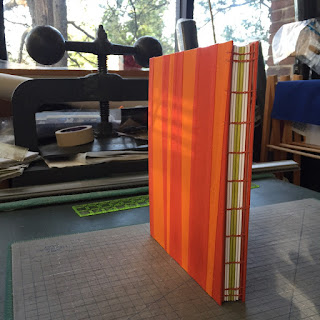I had a collection of fabrics I bought earlier shopping in Manassas at Hancock Fabrics and Joann's with my mom in a matched color way and then I added a little more from my stash. I decided to adjust the block pattern a little for my first repeat pattern curved piecing project. Tim used fat quarters and I had lots more fabric than he did so I added a quarter inch to my the edges of the curves to allow a 1/4 inch along the seam at the edges of the finished blocks. That was the only design change I made. I even used his pattern of quilting stitches for my quilt. but I wasn't as fast as his fast quilting goes. As a matter of fact, I realized once I was into the quilting it was way too much for me. I struggled to get the quilting done all year but finally have it completed it, bound and washed and dried.... Ready to share. It's a throw size 46 x 61 inches. I used black pearl cotton #8 to do the leaf pattern and echo the leaf shapes in the design.
The blocks finished up at 8 inches square for each leaf and took me one hour and 17 minutes to quilt completely using Tim's intricate design. The quilting shows up best in the salmon and sage green blocks and on the back solid salmon.
There is one block I left without black quilting veins that I tried to label on the reverse by embroidering my title block right on the finished quilt. I don't recommend labeling this way but maybe with practice I could do better...
 |
| The entire back shows the great leaf and circle in squares design of the intricate quilting pattern. label at the left near the center. |
This was a fun quilt and I loved the resulting quilting patterns but the labor made it something I would simplify for future hand quilting projects. I am grateful to Tim for giving us a good pattern to begin me down the curved piecing pathway. More to come! It's not as hard as you might think if you never did a curve look for help and give it a try once you get the hang of it you won't look back.


















